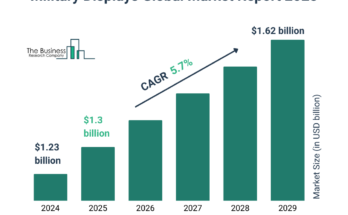Market Size –
The lab automation market size has grown strongly in recent years. It will grow from $6.67 billion in 2023 to $7.33 billion in 2024 at a compound annual growth rate (CAGR) of 9.9%. The growth in the historic period can be attributed to miniaturization of assays and instruments, advancements in robotics and automation technologies, increased demand for high-throughput screening in drug discovery, growth in emphasis on precision and reproducibility in research, and the need for faster and more accurate diagnostic testing.
The lab automation market size is expected to see rapid growth in the next few years. It will grow to $10.80 billion in 2028 at a compound annual growth rate (CAGR) of 10.2%. The growth in the forecast period can be attributed to regulatory compliance requirements, demand for remote access and monitoring, labor shortages and skills gap, growing demand for high-throughput screening, and cost reduction pressure. Major trends in the forecast period include integration of artificial intelligence (AI) and machine learning algorithms, expansion of robotic automation, adoption of modular and scalable automation solution, increased use of high-throughput screening technologies, incorporation of advanced imaging and microscopy techniques.
Order your report now for swift delivery @
https://www.thebusinessresearchcompany.com/report/lab-automation-global-market-report
Scope Of Lab Automation Market
The Business Research Company’s reports encompass a wide range of information, including:
1. Market Size (Historic and Forecast): Analysis of the market’s historical performance and projections for future growth.
2. Drivers: Examination of the key factors propelling market growth.
3. Trends: Identification of emerging trends and patterns shaping the market landscape.
4. Key Segments: Breakdown of the market into its primary segments and their respective performance.
5. Focus Regions and Geographies: Insight into the most critical regions and geographical areas influencing the market.
6. Macro Economic Factors: Assessment of broader economic elements impacting the market.
Lab Automation Market Overview
Market Drivers –
The rising demand for personalized medicine is expected to propel the growth of the lab automation market going forward. Personalized medicine, also known as precision medicine, refers to a medical approach that tailors healthcare decisions, practices, interventions, and treatments to individual patients. The demand for personalized medicine is on the rise due to several factors, including advancements in genomics and molecular diagnostics, increased awareness and education, a growing burden of chronic diseases, and its cost-effectiveness. Lab automation improves the efficiency, accuracy, and scalability of laboratory procedures, allowing healthcare professionals and researchers to develop personalized medicine approaches that improve patient outcomes and optimize treatment efficacy. For instance, in October 2022, according to the Personalized Medicine Coalition (PMC), a US-based organization that promotes understanding and adoption of personalized medicine, more than 75,000 genetic testing products and 300 personalized medicines will be on the market for people with multiple types of cancer, genetic rare diseases, and a range of chronic and infectious diseases. Thus, rising demand for personalized medicine is driving the growth of the lab automation market.
Market Trends –
Major companies operating in the lab automation market are developing innovative solutions, such as lab automation systems for microbiology laboratories, to help optimize lab space and streamline work flow. Lab automation systems for microbiology laboratories are advanced technological solutions designed to streamline and enhance the processing, analysis, and management of microbiological samples and data. For instance, in January 2023, Becton, Dickinson, and Company, a US-based medical technology company, launched the new third-generation BD Kiestra Total Lab Automation System for microbiology laboratories. The system is modular and capable of supporting and matching the requirements of laboratories, thereby improving laboratory operations, increasing budgetary efficiencies, and advancing laboratory outcomes. It is a sophisticated, completely automated robotic system that streamlines and improves microbiology laboratory procedures such as sample processing, digital imaging, incubation, and result analysis. Furthermore, several features, such as automated microbiology processes, modular and scalable design, the BD Synapys microbiology informatics solution, and high throughput processing, will transform clinical bacteriological testing, improve laboratory outcomes, and meet the changing needs of modern microbiology laboratories.
The lab automation market covered in this report is segmented –
1) By Stage Of Automation: Pre-Analytical Stage, Analytical Stage, Post-Analytical Stage, Total Lab Automation
2) By Process: Discrete Processing, Continuous Flow
3) By Application: Diagnostics, Genomic Solutions, Microbiology, Drug Discovery, Proteomic Solutions, Other Applications
4) By End-User: Pharmaceutical and Biotechnology Companies, Research and Diagnostic Laboratories, Other End-Users
Get an inside scoop of the lab automation market, Request now for Sample Report @
https://www.thebusinessresearchcompany.com/sample.aspx?id=15205&type=smp
Regional Insights –
North America was the largest region in the lab automation market in 2023. Asia-Pacific is expected to be the fastest-growing region in the forecast period. The regions covered in the lab automation market report are Asia-Pacific, Western Europe, Eastern Europe, North America, South America, Middle East, Africa.
Key Companies –
Major companies operating in the lab automation market report are <b>Thermo Fisher Scientific; Becton Dickinson And Company (BD); Agilent Technologies Inc.; PerkinElmer LLC; Beckman Coulter Inc.; Biomek Inc.; Bio-Rad Laboratories; QIAGEN N.V.; Tecan Group; Brooks Life Sciences; Hamilton Company; Promega Corporation; Opentrons Labworks Inc; Analytik Jena AG; Gilson Inc.; Eppendorf Corporate; Hudson Robotics; Cartesian Therapeutics; Labcyte Inc. (now part of Beckman Coulter Life Sciences); Zymo Research Corp.; Perceptive Instruments Ltd.; Synthace Ltd.; Festo Corp.; Roche Diagnostics; Peak Analysis & Automation (PAA) </b>
Table of Contents
1. Executive Summary
2. Lab Automation Market Report Structure
3. Lab Automation Market Trends And Strategies
4. Lab Automation Market – Macro Economic Scenario
5. Lab Automation Market Size And Growth
…..
27. Lab Automation Market Competitor Landscape And Company Profiles
28. Key Mergers And Acquisitions
29. Future Outlook and Potential Analysis
30. Appendix
Contact Us:
The Business Research Company
Europe: +44 207 1930 708
Asia: +91 88972 63534
Americas: +1 315 623 0293
Email: [email protected]
Follow Us On:
LinkedIn: https://in.linkedin.com/company/the-business-research-company
Twitter: https://twitter.com/tbrc_info
Facebook: https://www.facebook.com/TheBusinessResearchCompany
YouTube: https://www.youtube.com/channel/UC24_fI0rV8cR5DxlCpgmyFQ
Blog: https://blog.tbrc.info/
Healthcare Blog: https://healthcareresearchreports.com/
Global Market Model: https://www.thebusinessresearchcompany.com/global-market-model




